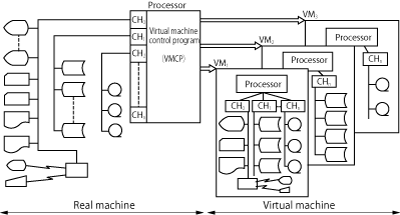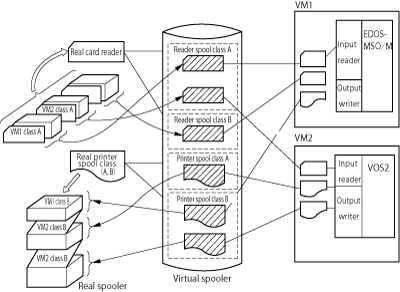A virtual machine system is a system that generates multiple virtual machines (VM) on a real machine and enables the OSs to operate independently on the corresponding VMs. There were three types of virtual machine systems for the M series computers: VMS, VMS/ES and VMS/AS. M series OSs and EDOS/MSO ran on these systems.
Figure 1 shows a conceptual diagram of VMS. A virtual machine control program (VMCP) was used to realize VM.

- Home >
- Historical Computers in Japan >
- Mainframe OS >
- Virtual Machine Systems VMS, VMS/ES and VMS/AS
【Hitachi】 Virtual Machine Systems VMS, VMS/ES and VMS/AS

VMS was completed in October 1979.
VMS/ES was an enhanced version of VMS that supported M series extended addressing, and was completed in October 1985. VMS/ES enabled execution of VOS3/ES1.
VMS/AS was a virtual machine system that enabled execution of VOS3/AS. It was completed in 1990.
Hitachi developed the virtual machine systems for the M series computers with the following objectives:
Allow leveling of the transition works and reduction in hardware facility cost in transition from the old system to the new system by allowing the new and old systems to operate simultaneously on a single real machine.
Allow multiple VMs to be configured beyond the framework of the real machine , a job to be executed under multiple OSs at the same time, and a system test to be performed. Enable flexible use patterns, such as development of a new system while performing a business operation, to be achieved.
The virtual machine systems for the M series computers had the following features.
| Item | Description |
|---|---|
| Achievement of higher performance | The performance of a virtual machine system relies greatly on the performance of the VMCP program, which controls allocation of the real machine resources, generates VMs and controls executions. This system achieved a higher performance through firmware VMA (VM Assist) for privileged-instruction simulation, resident VM storage, high-speed I/O simulation, etc. |
| Achievement of higher reliability | The system achieved higher reliability by directly adopting the RAS function of the OS for failures that the OS could handle directly and equipping the VMCP itself with an RAS function equal to or higher than that of the OS for hardware failures in simulation processing by the VMCP. |
| A broad range of center operation functions |
|
| OS handshaking | OSs, including VOS2, supported the measures to reduce VMCP overhead including restriction on issuance of privileged instructions as a handshaking function to be executed on VM. |
Figure 2 shows a conceptual diagram of the spooling of VMS. The spooling function of VMCP enabled unit recorders such as a card reader and a line printer to be shared among multiple VMs.
All Rights Reserved, Copyright (C) Information Processing Society of Japan

